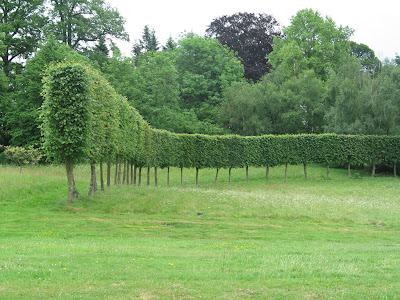(Read Previous Design 101 here)
Pleaching is the method of training multiple trees into a single horizontal plane, or one continuous line. It is often used to create allees or hedges. More frequently seen in European garden design, the training takes dedication to clipping and time to mature. Most often the branches are clipped to expose the trunks.
EXAMPLES OF PLEACHING
A classic example of pleached trees.
 |
| Image from Jinny Bloom |
These are European Hornbeams pleached into an Allee.
| Image n.mccullough |
RECOMMENDED TREES & PLANTING:
Trees that work well for pleaching include; Hornbeams, Linden/Lime, and Pear. My personal favorite to use are Hornbeams, but I am also experimenting using Buckthorns in my back yard. When planting you should look to 3-4 feet spacing between each tree.
Here you can see a more natural landscape with a line of pleached trees.
 |
| Image from here. |
| Image n.mccullough |
From this photo you can really see the structure of the branches creating the unified green wall. This very tall allee of pleached trees is at Arley Hall in England. |
| Image from here.
I could post 20 more photos of different gardens using pleached trees, but I am going to stop myself from going over board since I think you now understand the technique. Keep your eyes out, I think you will be noticing a lot more pleached trees. |

Hi there, LOVE THIS IDEA! I live in Highlands Ranch, CO and have just recently finished building planting beds made of manufactured bricks. The beds are deep and about 10 feet long and 3 feet wide, and create and enclosed square space. I would love to use this idea but am not sure which tree to use. And which will survive the winter. I want to come up with a plan. Boxwood and the base. Trees to block the view of surrounding yards. Mostly, I want to create a intimate private space.
Mary,
I love pleached trees and my go-to plant is the Upright European Hornbeam -Carpinus betulus ‘Frans Fontaine’ It stays very tight and is very dense…. Awesome tree and is hardy to zone 4
How much maintenance do pleached shrubs take?
I’ve been rather obsessed with espalier and pleached trees as of late and the other day I though of a perfect place to do an alley of pleached trees. In the search for appropriate trees, I’ve found that in England where it is much more common, there are many nurseries that sell trees specifically for this purpose (pre-pleached, as it were), but have had no luck finding anything on this side of the pond. My rough estimate is that I will need 8 or 10 trees, so obviously I need to keep the cost down a bit and I was thinking a larger bare root tree might be the most economical (and easiest) option. Do you know of any sources I might consult to find that? I’m particularly interested in the hornbeams you recommend, Carpinus betulus ‘Frans Fontaine’. Thanks in advance. Love the blog, by the way.
Erin,
Thank you so much for following! It is so easy to be obsessed when it looks so cool…. So I have had great success buying form Heritage Seedling, Inc. (www.heritageseedlings.com) from Salem Oregon. The quality is amazing and the selection is extensive. They have a number of Carpinus to choose from in various sizes.
From all my travels in England the Carpinus and Fagus were the two most common used the pleaching…. and from a lot of interacting with the gardeners most of the hedges were planted from young plants- be it bare root or saplings. The insta-hedge is a fairly recent thing in England (15-20 years).
Thanks again
I’ve been trying this myself, but I have serious doubts about whether I’m doing it right. Is there anyone in central Ohio who has experience with getting this to work?
John, I have just bought some very young Hornbeams and also live in CMH. Is there some way we can contact one another outside of this comment thread. I would love to know what your progress has been and what method you have used. Ursula
Hi! I know this is years after the original post, but I’m wondering if you know of good mail-order sources for Carpinus betulus? I’m in zone 4 but many nurseries in the area don’t carry it (only American Hornbeam, Carpinus caroliniana). Is that a good substitute? Any insight at all would be tremendously helpful. Thanks!
I’m pleaching a hedge in my back yard with a double row of 10 total C.caroliniana. I have 100% confidence. I planted 5′ tall dormant whips last fall after growing them from bare root in a Missouri Gravel bed for a year. They are about to break bud and this weekend I will be tying them to a wire strung between two posts. I have trained other American Hornbeams and really like their character as they age. Have fun and get dirty.
Dear Nathaniel,
I’m considering buying C. Carolinana for pleaching as it’s what’s available nearby. Can you update us on how it’s going? Many thanks,
Emily outside of Philadelphia
I buy mine from http://www.heritageseedlings.com/ . I’m pretty sure they are wholesale only, however I would start there…
I’m pleaching a hedge in my back yard with a double row of 10 total C.caroliniana. I have 100% confidence. I planted 5′ tall dormant whips last fall after growing them from bare root in a Missouri Gravel bed for a year. They are about to break bud and this weekend I will be tying them to a wire strung between two posts. I have trained other American Hornbeams and really like their character as they age. Have fun and get dirty.
Hi,
I’m waiting for the delivery of six Frans Fontaine. I’ve read what I can find regarding spacing and technique, but end up confused due to conflicting information. Some sources say to plant no less than 8′ apart for pleaching. Others recommend 3′-4′ or 6′. One source indicated Frans Fontaine is not a good choice for this application due to “how it grows,” but without explanation. My trees are coming in 7 gallon containers and I will be building the bamboo frames for training. If I’m understanding correctly, the spacing of the trees is determined by the width of the frame. Mature width for Frans Fontaine is in the neighborhood of 15′, according to what I’ve read. Does this mean my frame should be 8′ in width or can I build a 6′ width and bridge the gap with bamboo stakes when their growth requires additional support? If there is a comprehensive guide for me to follow, please advise. I would appreciate any help you can offer. I really want this to be a successful endeavor! Thank you, Gina
Pingback: Stunning Pleached Trees to Add Beauty for Your Outdoor Landscaping
Hi to every body, it’s my first visit of this weblog;
this webpage includes amazing and genuinely good data designed
for visitors.
These are genuinely ցrest ideas in regarding blogging. You have touchеd some nice things here.
Any way keep up wrinting.
Heree is my site debt consolidatfion (audius.co)